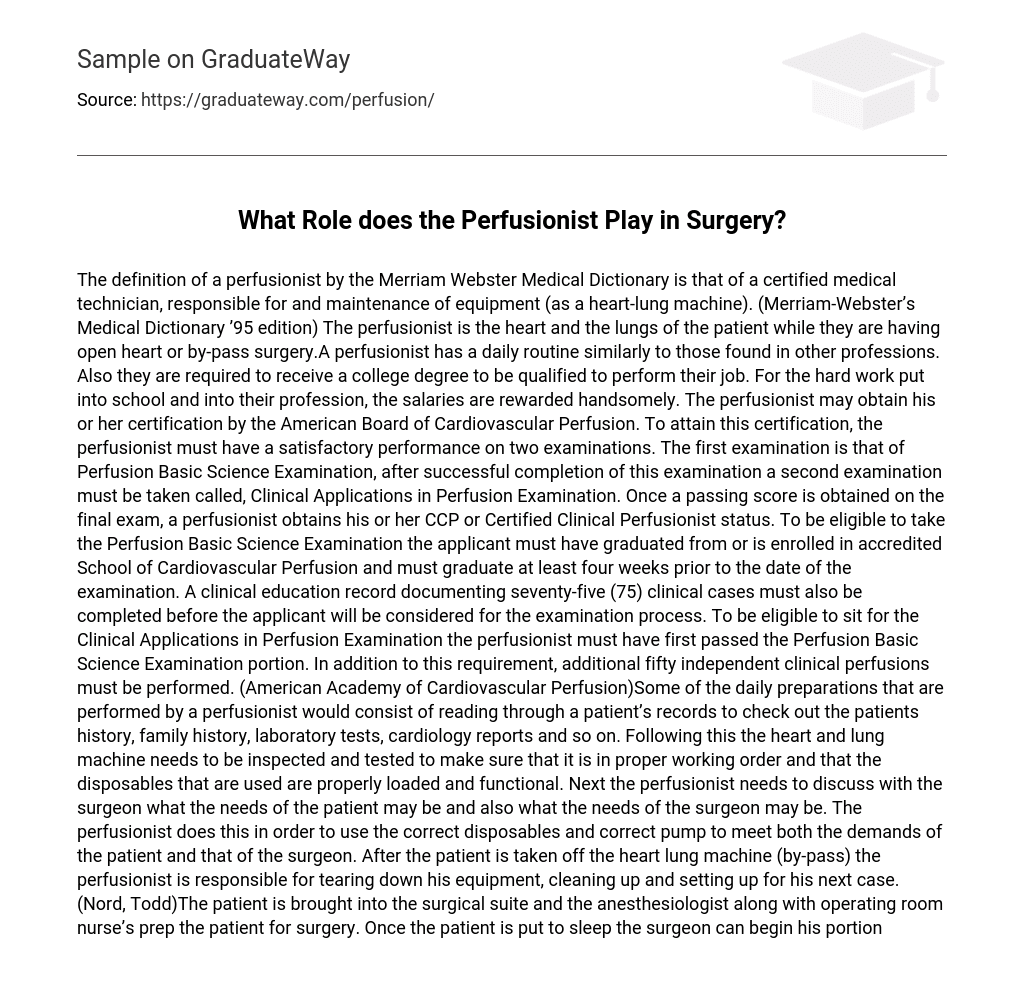According to the Merriam Webster Medical Dictionary, a perfusionist is a certified medical technician who is responsible for the maintenance of equipment, such as a heart-lung machine, during open heart or bypass surgery. They are considered the heart and lungs of the patient during these procedures. In order to qualify for this profession, perfusionists must obtain a college degree. Their hard work in school and in their profession is rewarded with handsome salaries. To become certified, perfusionists can obtain their certification through the American Board of Cardiovascular Perfusion. This requires passing two examinations: the Perfusion Basic Science Examination and the Clinical Applications in Perfusion Examination. Once a passing score is achieved on the final exam, the perfusionist obtains their Certified Clinical Perfusionist status. In order to be eligible to take the Perfusion Basic Science Examination, applicants must have graduated from or be enrolled in an accredited School of Cardiovascular Perfusion and must have graduated at least four weeks prior to the examination date.The American Academy of Cardiovascular Perfusion states that in order to be considered for the examination process, an applicant must complete a clinical education record documenting 75 clinical cases. Additionally, the perfusionist must have passed the Perfusion Basic Science Examination. Furthermore, an additional 50 independent clinical perfusions must be performed.
Before surgery, the perfusionist performs daily preparations which include reviewing the patient’s records such as medical history, family history, laboratory tests, and cardiology reports. The heart and lung machine is also inspected and tested to ensure it is working properly and the disposable items are correctly loaded. The perfusionist then consults with the surgeon to understand both the patient’s and surgeon’s needs. This helps in selecting the appropriate disposables and pump to meet their demands.
After the patient is taken off the heart lung machine, the perfusionist is responsible for dismantling the equipment, cleaning up, and preparing for the next case. In the surgical suite, the patient is prepared for surgery by the anesthesiologist and operating room nurses.Once the patient is anesthetized, the surgeon commences their part of the procedure by opening the chest and connecting the patient to the heart lung machine. This connection serves to stop the patient’s heart and lungs, allowing for a still operative site. Meanwhile, the perfusionist, working with the heart lung machine, assumes responsibility for the patient’s blood circulation and breathing. This process, known as extra-corporeal circulation (E.C.C), involves artificial organ function. The perfusionist must diligently monitor the changes in circulation and keep both the surgeon and anesthesiologist informed of the patient’s condition. Subsequently, after the surgery, the perfusionist continues to assist in regulating the patient’s blood circulation until everything is stabilized, at which point disconnecting the patient from the heart lung machine becomes possible.
The surgery suite is a sterile and clean environment in which the perfusionist must work, requiring physical endurance and effective communication skills. Adherence to safety precautions is crucial to prevent contamination of patients’ blood. The typical workweek for a perfusionist is forty hours, excluding on-call time which includes evenings, weekends, and holidays. Being on call may involve emergency procedures or monitoring recently operated patients at night. Therefore, a perfusionist should possess humanitarian qualities, collaborate with others, handle high stress levels, and make critical decisions without any errors that impact patients’ lives. The starting salary for a perfusionist is $72,800.00 per year but can increase up to $81,000.00 with experience. One can increase their salary by working in different medical areas or choosing employment with a hospital-contracted company.
(Source: Workforce New Jersey Public Information Network)
The opportunities for perfusionists are constantly evolving; what was common ten years ago is no longer the standard, and what is considered normal today will soon become outdated.
According to the Merriam Webster Medical Dictionary (1995 Edition), a perfusionist is responsible for maintaining equipment such as a heart-lung machine. The role includes using disposables and pumps to meet both the patient’s and surgeon’s requirements, while following safety precautions to prevent contamination of the patient’s blood.
Nord (2019) explains that these actions fulfill the needs of both the patient and surgeon. The American Academy of Cardiovascular Perfusion also states that completing fifty independent clinical perfusions is required. Moreover, numerous safety measures are essential in preventing contamination of patients’ blood (Workforce New Jersey Public Information Network).





